Contact
 Vanessa Schweizer
Vanessa Schweizer
Department of
Knowledge Integration
 Derek Armitage
Derek Armitage
School of Environment, Resources and Sustainability
 Anita Lazurko
Anita Lazurko
School of Environment, Resources and Sustainability
 Introduction
Introduction
Climate change is increasing the frequency and the severity of extreme events in river basins around the world, exacerbating the risk of flood and drought damages, disruptions to food production and ecosystem services and risks to human health. Efforts to build resilience to these impacts are complicated by the social–ecological interactions, cross-scale feedbacks, and diverse actor interests that influence the dynamics of change in social–ecological systems (SESs).
Scenarios are promising tools for explicitly engaging with complex and uncertain futures. This study uses a novel approach to develop and explore “big-picture” scenarios of a river basin under climate change by characterizing future change as emergent from interactions between diverse efforts to build resilience and a complex, cross-scale SES. It further aimed to explore the potential for the study method to surface diverse perspectives and drivers of change in SESs through a transdisciplinary scenario modeling process.
Methodology
The Red River Basin, which covers parts of the United States midwest and southcentral Canada, was used as the case study. The basin is governed by a complex arrangement of institutions from community to federal and transboundary level, and is the homeland of diverse First Nations, Métis, and Tribal communities.
The cross-impact balances (CIB) method, a semi-quantitative approach that applies systems theory to generate internally consistent narrative scenarios from a network of interacting drivers of change or critical uncertainties was used. The CIB modeling process began with the determination of a set of descriptors, which are the most important and uncertain drivers of change influencing the future of a system. The uncertainty of each descriptor was represented by a small number of variants or mutually exclusive outcomes. Scenarios included one variant for each descriptor. The systemic interactions between descriptors were determined by considering influence judgments between variants, with influence judgments for the whole system captured in a cross-impact matrix. A social-ecological scenario framework was developed to bring together existing knowledge about the dynamics of SES change and the structure of the CIB method and to allow for systematic and transparent scenario development (Figure 1).
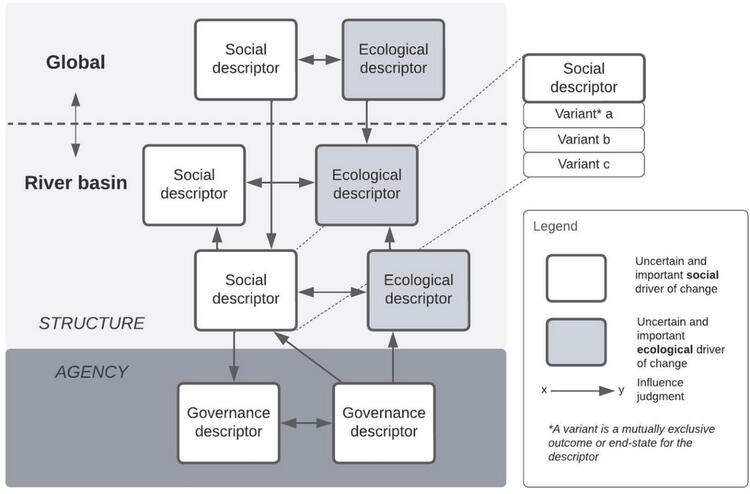
Figure 1: Social–ecological scenario framework.
The study used a six-step participatory scenario modeling process (Figure 2). Round 1 and 2 included semi-structured interviews with 34 and 11 experts and opinion leaders respectively who identified critical drivers of change and influence judgements. A literature review triangulated interview data, while an atypical sensitivity analysis was conducted to determine how changes to input data for CIB changed the model structure. ScenarioWizard was used to determine which internally consistent scenarios were common across model prototypes and were robust to model uncertainty. Frequency statistics, bias statistics and active–passive diagrams generated further insights. Implications of three water governance strategies were modeled and compared to the original six prototypes. The (re)integrating knowledge phase required translating model outputs into formats, such as narratives and visual art, that could be shared to stimulate discussion at the debrief workshop.
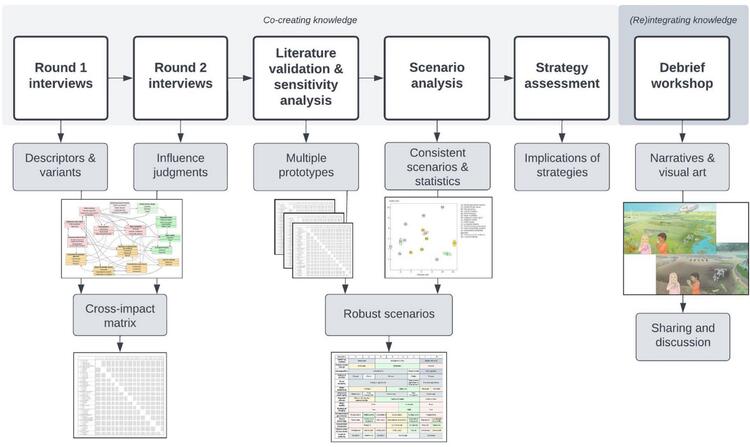
Figure 2: Six-step transdisciplinary scenario modeling process.
Outcomes
The participatory scenario modeling generated fifteen interacting descriptors with multiple variants that describe a range of mutually exclusive outcomes. Influence judgments characterize social–ecological and cross-scale interactions between descriptors and variants, generating an influence diagram for the basin (Figure 3). The sensitivity analysis generated six model prototypes each generating 13–23 internally consistent scenarios with eight scenarios being sufficiently robust to model uncertainty (Figure 4).
Scenarios revealed important insights into the future of the Red River Basin under climate change. For example, independent governance, patchwork data and other generally undesirable governance interventions tended to co-occur (e.g., scenario 3, 6, and 7), contributing to poor environmental outcomes. More desirable governance interventions, such as collaborative governance and integrated data, also co-occur (e.g., scenario 1, 2, 4, and 5), improving environmental outcomes. The state of global descriptors, however, retained a strong influence over environmental outcomes, sometimes overshadowing positive governance interventions (e.g., scenario 1).
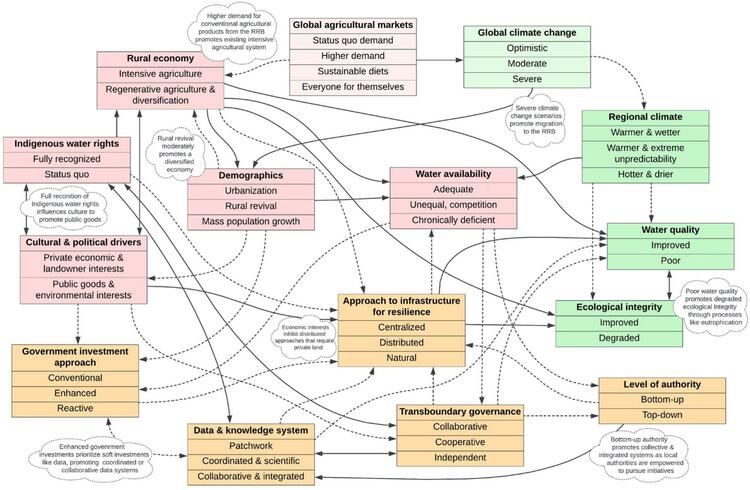
Figure 3: Descriptors, variants and influence judgments in the scenario model. Arrows indicate judgment sections containing non-zero influence judgments, dashed lines represent influence judgments that remained uncertain, bi-directional arrows represent influence judgments in each direction.
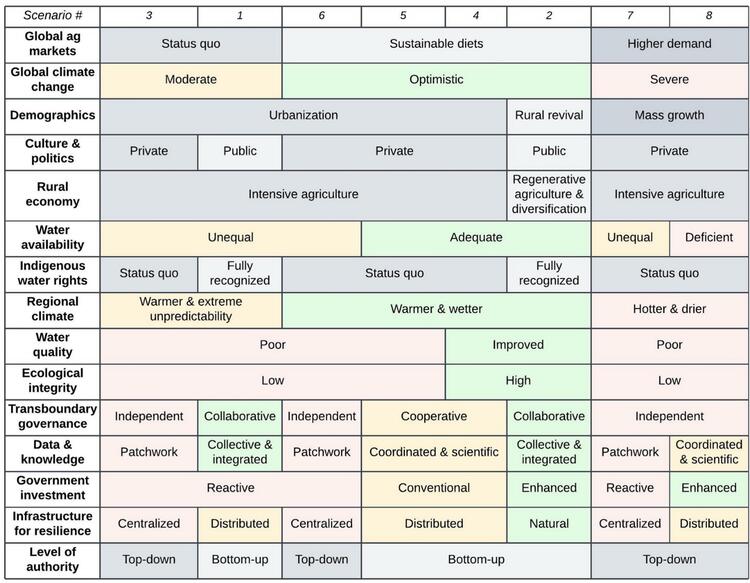
Figure 4: Scenario tableau depicting eight robust scenarios.
Figure 5 depicts the active–passive diagram of descriptors, with descriptors in the top left quadrant having a highly influential role on the system, descriptors in the bottom right quadrant being strongly influenced by other descriptors and descriptors in the top right quadrant being both strongly influencing and influenced by other descriptors. The bias statistics and active–passive diagram revealed important implications for resilience, such as the presence of strong restricting influences on the natural ecosystems approach to infrastructure indicating that transformative change may be required for this approach to be implemented. Importantly, the combination of full recognition of Indigenous water rights together with more desirable governance characteristics led to more desirable outcomes overall.
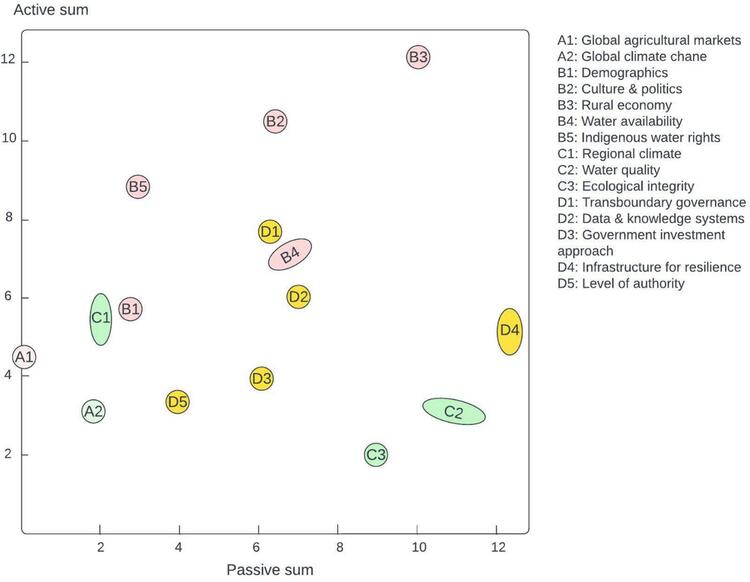
Figure 5: Active–passive diagram.
Workshop participants agreed on the best- and worst-case scenarios and discussed implicit trade-offs. For example, participants discussed scenario 4 as desirable, but recognized it only seemed to benefit those with power. Participants also recognized that the most desirable scenario (i.e., scenario 2) represented the most significant transformation from the status quo. Participants agreed that the most plausible scenarios by 2050 were those that do not depart significantly from the status quo. Findings showed that participants not only hold divergent perspectives, but that participants may interpret scenarios according to their different views and interests.
Conclusions
The study’s “big picture” scenarios identified and described significant complexities surrounding efforts to build resilience in the Red River Basin under climate change, affirmed the potential for the CIB method to generate unique insights about the trajectory of SESs and identified three important findings for basin management actors. First, the internally consistent scenarios integrate a wide range of drivers and a broad scope of outcomes that actors can use in strategy and policy making. Second, the CIB matrix characterizes the basin as a complex landscape of social–ecological interactions, exposing key variables and feedbacks affecting it’s future trajectory that actors can use to enrich their understanding of the system while situating solutions within a bigger picture and connecting initiatives to potential long-term implications. Finally, the sensitivity analysis generated scenarios that are robust yet revealed uncertainty and disagreement regarding how drivers of change interact that may direct future research.
The study offers important implications for sustainability science. First, the CIB method synthesized the expertise of diverse participants by integrating drivers of change represented by quantitative and qualitative knowledge, enabling the development of “big picture” scenarios. Second, the unique approach used for sensitivity analysis acknowledged and systematically embedded a wide range of uncertainties into the scenario process. Finally, the study demonstrated the use of a guiding framework allowing for a systematic and transparent scenario analysis leveraging compatibilities between SES theory and the CIB method.
Read more in Sustainability Science
Lazurko, A., Schweizer, V. & Armitage, D. Exploring “big picture” scenarios for resilience in social–ecological systems: transdisciplinary cross-impact balances modeling in the Red River Basin. Sustainability Science, April 2023. https://doi.org/10.1007/s11625-023-01308-1
For more information about WaterResearch, contact Julie Grant.
Image by wirestock on Freepik.






